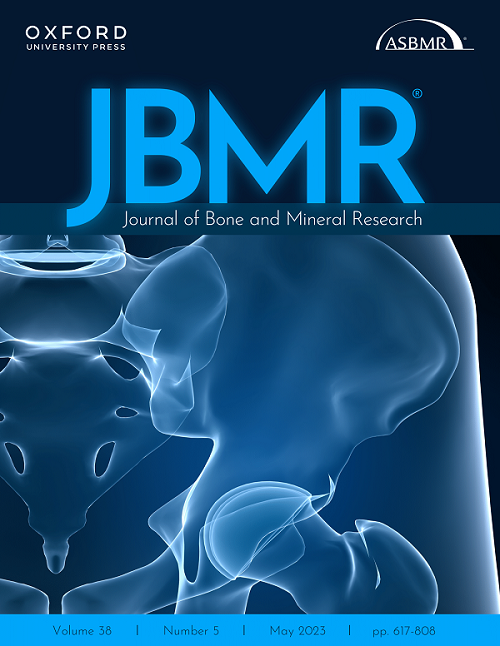Roy B. Choi, April M. Hoggatt, Daniel J. Horan, Emily Z. Rogers, Gabriela G. Loots, Alexander G. Robling
下载PDF
{"title":"Sostdc1 Suppression in the Absence of Sclerostin Potentiates Anabolic Action of Cortical Bone in Mice","authors":"Roy B. Choi, April M. Hoggatt, Daniel J. Horan, Emily Z. Rogers, Gabriela G. Loots, Alexander G. Robling","doi":"10.1002/jbmr.4798","DOIUrl":null,"url":null,"abstract":"<p>The development of Wnt-based osteoanabolic agents has progressed rapidly in recent years, given the potent effects of Wnt modulation on bone homeostasis. Simultaneous pharmacologic inhibition of the Wnt antagonists sclerostin and Dkk1 can be optimized to create potentiated effects in the cancellous bone compartment. We looked for other candidates that might be co-inhibited along with sclerostin to potentiate the effects in the cortical compartment. Sostdc1 (Wise), like sclerostin and Dkk1, also binds and inhibits Lrp5/6 coreceptors to impair canonical Wnt signaling, but Sostdc1 has greater effects in the cortical bone. To test this concept, we deleted Sostdc1 and Sost from mice and measured the skeletal effects in cortical and cancellous compartments individually. Sost deletion alone produced high bone mass in all compartments, whereas Sostdc1 deletion alone had no measurable effects on either envelope. Mice with codeletion of Sostdc1 and Sost had high bone mass and increased cortical properties (bone mass, formation rates, mechanical properties), but only among males. Combined administration of sclerostin antibody and Sostdc1 antibody in wild-type female mice produced potentiation of cortical bone gain despite no effect of Sostdc1 antibody alone. In conclusion, Sostdc1 inhibition/deletion can work in concert with sclerostin deficiency to improve cortical bone properties. © 2023 The Authors. <i>Journal of Bone and Mineral Research</i> published by Wiley Periodicals LLC on behalf of American Society for Bone and Mineral Research (ASBMR).</p>","PeriodicalId":185,"journal":{"name":"Journal of Bone and Mineral Research","volume":"38 5","pages":"765-774"},"PeriodicalIF":5.1000,"publicationDate":"2023-03-09","publicationTypes":"Journal Article","fieldsOfStudy":null,"isOpenAccess":false,"openAccessPdf":"https://onlinelibrary.wiley.com/doi/epdf/10.1002/jbmr.4798","citationCount":"1","resultStr":null,"platform":"Semanticscholar","paperid":null,"PeriodicalName":"Journal of Bone and Mineral Research","FirstCategoryId":"3","ListUrlMain":"https://onlinelibrary.wiley.com/doi/10.1002/jbmr.4798","RegionNum":1,"RegionCategory":"医学","ArticlePicture":[],"TitleCN":null,"AbstractTextCN":null,"PMCID":null,"EPubDate":"","PubModel":"","JCR":"Q1","JCRName":"ENDOCRINOLOGY & METABOLISM","Score":null,"Total":0}
引用次数: 1
引用
批量引用
Abstract
The development of Wnt-based osteoanabolic agents has progressed rapidly in recent years, given the potent effects of Wnt modulation on bone homeostasis. Simultaneous pharmacologic inhibition of the Wnt antagonists sclerostin and Dkk1 can be optimized to create potentiated effects in the cancellous bone compartment. We looked for other candidates that might be co-inhibited along with sclerostin to potentiate the effects in the cortical compartment. Sostdc1 (Wise), like sclerostin and Dkk1, also binds and inhibits Lrp5/6 coreceptors to impair canonical Wnt signaling, but Sostdc1 has greater effects in the cortical bone. To test this concept, we deleted Sostdc1 and Sost from mice and measured the skeletal effects in cortical and cancellous compartments individually. Sost deletion alone produced high bone mass in all compartments, whereas Sostdc1 deletion alone had no measurable effects on either envelope. Mice with codeletion of Sostdc1 and Sost had high bone mass and increased cortical properties (bone mass, formation rates, mechanical properties), but only among males. Combined administration of sclerostin antibody and Sostdc1 antibody in wild-type female mice produced potentiation of cortical bone gain despite no effect of Sostdc1 antibody alone. In conclusion, Sostdc1 inhibition/deletion can work in concert with sclerostin deficiency to improve cortical bone properties. © 2023 The Authors. Journal of Bone and Mineral Research published by Wiley Periodicals LLC on behalf of American Society for Bone and Mineral Research (ASBMR).
硬化蛋白缺失时Sostdc1抑制增强小鼠皮质骨的合成代谢作用
近年来,基于Wnt的骨合成代谢药物的开发进展迅速,因为Wnt对骨稳态的调节具有强大的作用。Wnt拮抗剂sclerostin和Dkk1的同时药理抑制可以优化以在松质骨室中产生增强作用。我们寻找其他可能与硬化蛋白共同抑制的候选药物,以增强皮质腔室的作用。Sostdc1 (Wise)与sclerostin和Dkk1一样,也能结合并抑制Lrp5/6共受体,从而损害典型的Wnt信号,但Sostdc1在皮质骨中的作用更大。为了验证这一概念,我们从小鼠中删除了Sostdc1和Sost,并分别测量了皮质和松质室的骨骼效应。单独的Sost缺失在所有隔室中产生高骨量,而单独的Sostdc1缺失对两个包膜都没有可测量的影响。编码Sostdc1和Sost的小鼠具有较高的骨量和增加的皮质特性(骨量,形成率,力学特性),但仅在雄性中存在。在野生型雌性小鼠中,联合使用sclerostin抗体和Sostdc1抗体可以增强皮质骨的生长,而单独使用Sostdc1抗体则没有作用。总之,Sostdc1抑制/缺失可以与硬化蛋白缺乏协同工作,以改善皮质骨特性。©2023作者。由Wiley期刊有限责任公司代表美国骨与矿物研究协会(ASBMR)出版的骨与矿物研究杂志。
本文章由计算机程序翻译,如有差异,请以英文原文为准。

 求助内容:
求助内容: 应助结果提醒方式:
应助结果提醒方式:


